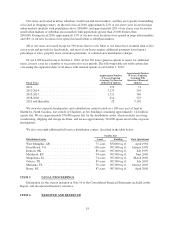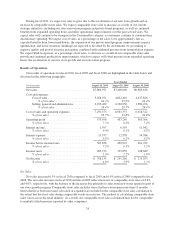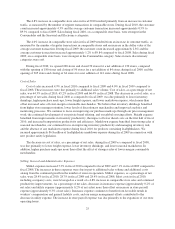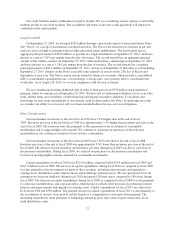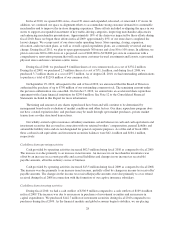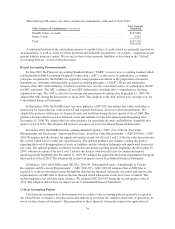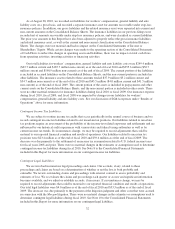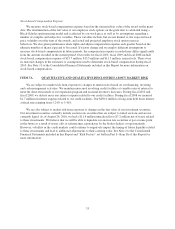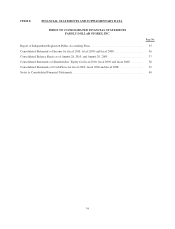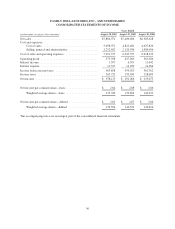Family Dollar 2010 Annual Report Download - page 31
Download and view the complete annual report
Please find page 31 of the 2010 Family Dollar annual report below. You can navigate through the pages in the report by either clicking on the pages listed below, or by using the keyword search tool below to find specific information within the annual report.Our credit facilities mature within the next twelve months. We are considering various options to extend the
maturity profile of our credit facilities. The availability and terms of any new credit agreement will depend on
conditions in the credit markets.
Long-Term Debt
On September 27, 2005, we obtained $250 million through a private placement of unsecured Senior Notes
(the “Notes”) to a group of institutional accredited investors. The Notes were issued in two tranches at par and
rank pari passu in right of payment with our other unsecured senior indebtedness. The first tranche has an
aggregate principal amount of $169 million, is payable in a single installment on September 27, 2015, and bears
interest at a rate of 5.41% per annum from the date of issuance. The second tranche has an aggregate principal
amount of $81 million, matures on September 27, 2015, with amortization commencing on September 27, 2011,
and bears interest at a rate of 5.24% per annum from the date of issuance. The second tranche has a required
principal payment of $16.2 million on September 27, 2011, and on each September 27 thereafter to and including
September 27, 2015. Interest on the Notes is payable semi-annually in arrears on the 27th day of March and
September of each year. The Notes contain certain restrictive financial covenants, which include a consolidated
debt to consolidated capitalization ratio, a fixed charge coverage ratio, and a priority debt to consolidated net
worth ratio. As of August 28, 2010, we were in compliance with all such covenants.
We are considering incurring additional debt in order to fund part of our $750 million stock repurchase
program, which we announced on September 29, 2010. We have not yet determined whether to do so or in what
form, and the terms and availability of debt financing will depend on market conditions. To facilitate new
borrowing, we may make amendments to our existing credit facilities and/or the Notes. In analyzing our credit
we consider our ability to service not only our financial indebtedness but also our lease obligations.
Other Considerations
Our merchandise inventories at the end of fiscal 2010 were 3.4% higher than at the end of fiscal
2009. Inventory per store at the end of fiscal 2010 was approximately 1.5% higher than inventory per store at the
end of fiscal 2009. The increases were due primarily to the expansion of our assortment of consumable
merchandise and to support higher sales growth. We continue to constrain our purchases of discretionary
merchandise as our customers continue to focus on basic consumables.
Our merchandise inventories at the end of fiscal 2009 were 3.8% lower than at the end of fiscal 2008.
Inventory per store at the end of fiscal 2009 was approximately 5.0% lower than inventory per store at the end of
fiscal 2008. The decrease in total inventory and inventory per store during fiscal 2009 was due to a decrease in
discretionary merchandise. During fiscal 2009, we reduced our purchases of discretionary merchandise and
focused on meeting higher customer demand for consumable merchandise.
Capital expenditures for fiscal 2010 were $212.4 million compared with $155.4 million in fiscal 2009 and
$167.9 million in fiscal 2008. The increase in capital expenditures during fiscal 2010 as compared to fiscal 2009
was due primarily to the investments we made to drive revenues, including improvements and upgrades to
existing stores, distribution center improvements and technology-related projects. We also purchased 20 of our
existing stores from our landlords during fiscal 2010 and opened 200 new stores compared to 180 stores during
fiscal 2009. The decrease in capital expenditures during fiscal 2009 as compared to fiscal 2008 was due primarily
to a decrease in distribution- and corporate-office-related projects, which offset increases in technology-related
projects and improvements and upgrades to existing stores. Capital expenditures for fiscal 2011 are expected to
be between $300 and $350 million. The planned increase in capital expenditures in fiscal 2011 is due primarily to
the acceleration of our new store growth and the launch of a comprehensive store renovation program. The
remaining expenditures relate primarily to technology-related projects and costs to begin construction of our
tenth distribution center.
27



